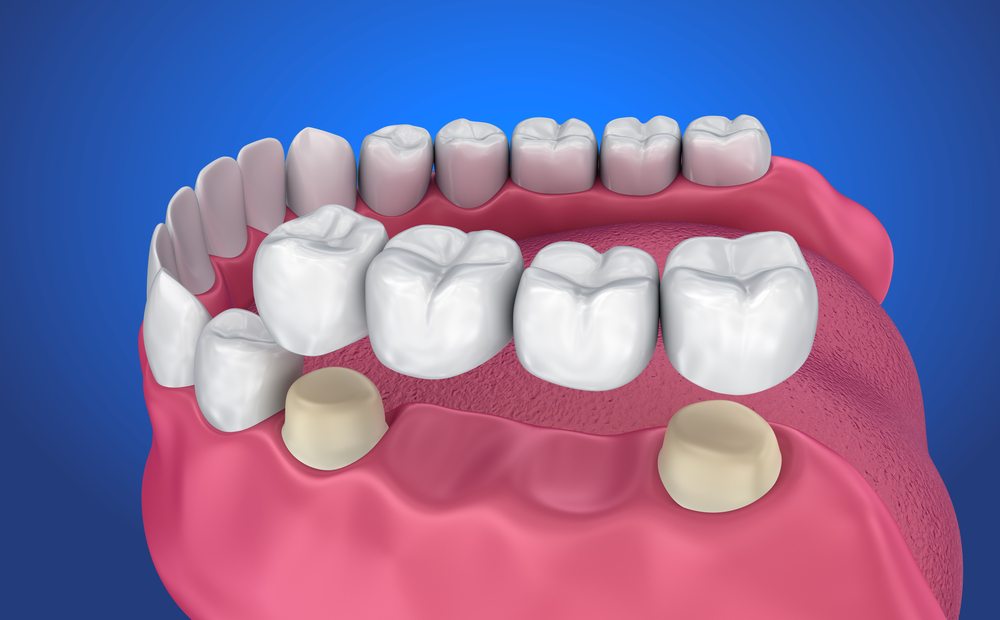ALL CERAMIC BRIDGES
An all ceramic bridge is a good alternative to the standard porcelain fused to metal bridge which was the standard choice of bridge for many people. But advances in dental technology have resulted in strong, long lasting materials such as ceramic which means it is possible to produce a bridge which is pleasing to the eye. A good example of this type of bridge is the zirconia bridge. This is discussed in more detail in a separate section. An all ceramic bridge is often a preferred form of treatment for a missing tooth or teeth.
WHAT IS A CERAMIC BRIDGE?
A ceramic bridge is similar to a conventional type of bridge in that it is comprised of a false tooth (pontic) and a couple of crowns which act as an anchor for the false tooth. The pontic is made from a variety of material such as gold or alloy but in this case it is made from ceramic. Plus the two crowns which accompany this are also made from ceramic. This makes for a very strong type of bridge which is further reinforced with a ceramic substructure which ensures that it will last for a very long time.
ADVANTAGES OF A CERAMIC BRIDGE
Its strength is a definite advantage but allied to this is the attractive translucent finish of the pontic and crowns which give it a realistic appearance. This type of bridge is practically indistinguishable from your normal teeth. Another bonus is that there is no fear of seeing a grey line at the edge of the gums. This is a particular problem with the porcelain fused to metal bridge which tended to display itself, especially at the edge of the gums. But the all ceramic bridge removes that worry. No metal is used in the construction of the bridge plus the bridge is fitted above the edge of the gums. This ensures that your teeth and gums remain healthy and with minimal risk of an infection. Plus they are a good choice of bridge for anyone with an allergy to metal.
DISADVANTAGES OF A CERAMIC BRIDGE
Whilst this is a good choice of bridge there are a few disadvantages which you need to take into account. These include: The ceramic can wear down the natural teeth on either side of the bridge. Heightened sensitivity of your teeth to different temperatures, e.g. hot drinks. Bacteria can become trapped around the bridge which if not removed, may lead to an infection. Ceramic bridges can be expensive They are prone to cracking or breaking Another consideration is the risk of a bacterial infection caused by smoking. If you are a smoker then take note that this increases the number of bacteria in your mouth which then increases the risk of an infection.
HOW IS A CERAMIC BRIDGE FITTED?
The dentist will examine your teeth and gums and ask you a series of questions before deciding whether you are suitable for a bridge.
If you are suitable then the procedure is in two stages as follows:
STAGE ONE
The dentist will prepare your teeth for the bridge. This preparation involves cleaning and reshaping the tooth so that it is in a good condition for the bridge. This may mean removing a sliver of the tooth so that it will be a perfect fit. What is important is the condition of the teeth either side of the gap in your teeth. These will be acting as a support for the bridge so it is vital that they are healthy and free from decay. If they are not then they will require some work before you are fitted for a bridge. Following this, the dentist will take an impression of your teeth with a mould. This is a container filled with dental putty which is used by a dental laboratory as a blueprint for the production of your bridge. The idea is that this mould is used to produce a model of your teeth which ensures that you receive a bridge which fits exactly within your mouth.
STAGE TWO
You will have been fitted with a temporary bridge whilst your new bridge is being fabricated. This will usually be for two to three weeks. You will be notified once your new bridge is ready. The dentist will fit the new bridge into your mouth and will check the fit, appearance and position. He or she will want to be certain that it is comfortable, fits well and that you are pleased with the result. Once this has been agreed the bridge is then secured in place with dental cement. The dentist will provide you with instructions on caring for your bridge as part of a daily hygiene routin.

